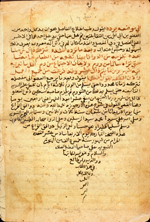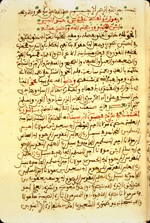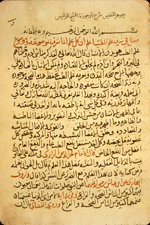Catalogue: Medical Poetry
 Commentaries on the Urjūzah fī al-ṭibb of Ibn Sīnā (Avicenna):
Commentaries on the Urjūzah fī al-ṭibb of Ibn Sīnā (Avicenna):
The medical poem of Ibn Sīnā's inspired a number of commentaries, including an important one by the Spanish physician Ibn Rushd (Averroes), a copy of which is preserved at NLM. Two additional commentaries are in the collections of NLM: a rather rare one written in the 15th century by Mūsá ibn Ibrāhīm al-Baghdādī and a unique copy of a hitherto unknown commentary written earlier in the same century by ‘Alī ibn ‘Abd Allāh ibn Haydūr.
-
 Sharḥ urjūzat Ibn Sīnā fī al-ṭibb / Sharḥ ‘alá alfīyah (MS A 59)
Sharḥ urjūzat Ibn Sīnā fī al-ṭibb / Sharḥ ‘alá alfīyah (MS A 59) - (Commentary on Ibn Sīnā's Poem 'On Medicine' / Commentary on the Thousand [Verses])
- شرح ارجوزة ابن سينا فى الطب / شرح على الفيه
- by Abū al-Walīd Muḥammad ibn Aḥmad ibn Muḥammad Ibn Rushd (Averroes) (d. 1198/595 H)
- ابو الوليد محمد ابن احمد ابن محمد ابن رشد
The poem on medicine by Ibn Sīnā was the subject of many commentaries, the most popular of which was written by the Spanish physician Ibn Rushd (Averroes), who died in 1198. It was most often referred to as Sharḥurjūzat Ibn Sīnā fī al-ṭibb ("Commentary on Ibn Sīnā's Poem on Medicine") or as Sharḥ manzumah fī al-ṭibb ("Commentary on the Poem on Medicine"). In the copy at NLM, however, the title is given as Sharḥ ‘alá alfīyah ("Commentary on the Thousand [Verses]"), a reference to the number of verses in the poem by Ibn Sīnā (although the poem usually contains 1326 verses). The commentary is a prose commentary interspersed with lines from Ibn Sīnā's poem, usually written in red ink to contrast with the black-ink prose commentary.
It is preserved today in many copies. For other manuscript copies, see G. C. Anawati, Mu'allafat Ibn Sīnā: Essai de bibliographie Avicennienne (Cairo: Dar al-Ma‘arif, 1950), pp. 175 entry no. 114; Corpus medicorum arabico-hispanorum, compiled by Carmen Peña, Amador Diaz, Camilo Alvarez de Morales, Fernando Girón, Rosa Kuhne, Concepción Vázques, and Ana Labarta, Awraq, 1981, volume 4, pp.79-111, esp. p 93 no. 26/3; Ullmann, Medizin, p. 167 note 2; GAL vol. 1, p. 457 (596) no. 81-Cmt.a and GAL-S vol.1, p. 823 no. 81-comm.a. See also London, Wellcome Library for the History and Understanding of Medicine, Haddad Coll. MS 478; and Savage-Smith, "Bodleian", MS Hunt. 502, item 3; MS Laud. Or. 5, item 1.
Sharḥ ‘alá alfīyah (MS A 59)
Illustrations
The colophon from a copy of Ibn Rushd's (Averroes) 12th-century commentary on the Poem on Medicine written by Ibn Sīnā (Avicenna). According to this colophon, the copy was completed on the 16th of the month of Dhu al-Qa‘dah 1005 [1 July 1597] from a copy finished on 8 Sha‘ban 633 [15 May 1236].
Physical Description
Arabic. 163 pages. Dimensions 20.2 x 14.7 (text area 16.3 x 11.0) cm; 27 lines per page. The title Sharḥ ‘alá alfīyah ("Commentary on the Thousand [Verses]") is given in a rubricated heading on p. 1, lines 2 and 5. The author's name is also given in the rubricated heading on p. 1, lines 3-4, as Abū al-Walīd Muḥammad ibn Aḥmad ibn Muḥammad Ibn Rushd.
The copy is dated in the colophon, lines 12-17) where it is said that the unnamed copyist completed it on the 16th of the month of Dhu al-Qa‘dah 1005 [1 July 1597] from a copy finished on 8 Sha‘ban 633 [15 May 1236].
A complete copy. The text is written in three different hands. Pages 52-163 are written in naskh script; black ink with headings and poetry being commented upon in red; catchwords. Pages 8-51 are written in a similar naskh script but by a different hand, also using 27 lines per page; black ink with the text being commented upon indicated by black overlinings; there are also some red overlinings and some marginal corrections; catchwords. The first seven pages are more recent replacements for apparently damaged pages; they are written in a North African (Maghribi) script (text area 14.5 x 9.2 cm; 23-26 lines per page) using gray ink with headings and text being commented upon written in magenta. The volume is paginated rather than foliated.
There are scattered marginalia in later hands.
The paper of pages 52-163 is a glossy cream paper with visible laid lines and single chain lines. The paper of pages 8-51 is very similar but slightly more browned and wormeaten, and it appears older. The paper of the replacement leaves (pages 1-7) is an ivory paper with visible laid and single chain lines.
The volumes consists of 163 pages plus one preliminary leaf which is blank except for penciled annotations.
Binding
The volume is bound in a red-leather modern library binding with envelope flap. There are modern pastedowns and endpapers.
Provenance
Purchased in 1941 by the Army Medical Library from A.S. Yahuda, who acquired it in Fez, Morocco (ELS 1727 Med. 68).
References
Schullian/Sommer, Cat. of incun. & MSS., entry A59, p. 316.
Hamarneh, "NLM", p. 94
NLM Microfilm Reel: FILM 48-123 no. 6
 al-Durrah al-ḥasnā’ fī sharḥ Qaṣīdat Ibn Sīnā (MS A 45.1, item 2)
al-Durrah al-ḥasnā’ fī sharḥ Qaṣīdat Ibn Sīnā (MS A 45.1, item 2)- (The Beautiful Pearl Concerning a Commentary on the Poem of Ibn Sīnā)
- الدرة الحسناء فى شرح قصيدة ابن سينا
- by ‘Alī ibn ‘Abd Allāh ibn Haydūr (d. 1413/816 H)
- على ابن عبد الله ابن هيدور
This commentary on the famous poem by Ibn Sīnā (Avicenna) was composed by a late 14th-century writer on plague, ‘Alī ibn ‘Abd Allāh ibn Haydūr. Until the discovery of this manuscript at NLM, it was not recognized that he had composed a commentary on Ibn Sīnā's poem, though other writings by him are known, including a commentary on a treatise concerned with arithmetic. His treatise on plague (al-amrad al-waba'iyah) is preserved in Morocco, Rabat, al-Khazanah al-‘ammah, MS. 9605; see Muhammad al-‘Arbi al-Khattabi, Faharis al-Khizanah al-Malikiyyah, II: al-tibb wa-al-saydala wa-al-baytarah wa-al-hayawan wa-al-nabat (Rabat: Mataba‘at al-Najah al-Jadidah, 1982) p. 31 no. 5. For other biographical information, and his commentaries on arithmetics, see Khayr al-Din al-Zirikli, al-A‘lam: Qamus tarajim li-ashhar al-rijal wa-al-nisa' min al-‘arab wa-al-musta‘ribin wa-al-mustashriqin, 8 vols. (Beirut: Dar al-‘Ilm lil-Malayin, 1970), vol. 4, p. 307.
During the course of the commentary ‘Alī ibn ‘Abd Allāh ibn Haydūr cites several authorities, including Ibn Rushd (Averroes), whose own commentary on Ibn Sīnā's poem was catalogued above (MS A 59), and a celebrated Sufi poet Ibn al-Farid, who died in Cairo in 1235/632 H (for the latter see GAL vol. 1, pp. 262-3 [305-7] and GAL-S vol. 1, p. 462-5).
No other copy is recorded. The commentary has not been published.
al-Durrah al-ḥasnā’ fī sharḥ Qaṣīdat Ibn Sīnā (MS A 45.1, item 2)
Illustrations
The opening of a commentary on Ibn Sīnā's [Avicenna's] famous poem written by ‘Alī ibn ‘Abd Allāh ibn Haydūr, who died in 1413/816 H. This is the only recorded copy of this commentary. It is undated and was made in North Africa probably in the 18th century.
Physical Description
Arabic. 42 leaves (fols. 82a-123b). Dimensions 20.5 x 14.5 (text area 15.5 x 9) cm; 23 lines per page. The title is given on fol. 82a, lines 12-13, and the author's name is given as ‘Alī ibn ‘Abd Allāh ibn Haydūr on lines 2-3 of the same folio.
The copy is undated and unsigned. The appearance of the paper, script, and ink suggests an 18th-century date.
A complete copy. The text is written in a medium-large, somewhat awkward, Maghribi script. Black ink with headings in red and green. There are red and green overlinings and occasional green-dot text stops.
There are scattered marginalia and marginal topic-headings.
The thin, ivory paper has horizontal thin laid lines and vertical single chain lines; no watermarks were observed. The edges have been trimmed from their original size. The paper is now very fragile and very wormeaten.
The volume consists of 204 leaves. Item 1 (fols. 1a-81b) is al-Sha‘rānī's epitome of the Tadhkirah by al-Suwaydi (MS A 45.1, item 1); item 2 is the commentary by ‘Alī ibn ‘Abd Allāh ibn Haydūr here catalogued; and item 3 (fols. 124a-204b) is a treatise on materia medica attributed to Yūḥannā ibn Bukhtīshū‘ (MS A 45.1, item 3). All three items were copied by the same hand.
Binding
The volume is bound in pasteboards with envelope flap, covered in red leather. The covers have a blind stamped medallion with gilt edging design and vertical line, surrounded by three concentric frames with the inner corners marked with gilt stamped flower designs. The fore-edge flap is stamped with the same flower design. The envelope flap has a medallion and frame design similar to that on the covers. There are modern pastedowns and endpapers. The spine has been repaired.
Provenance
No information is available on provenance nor on when it entered the collections at NLM.
References
Uncatalogued and unpublished. Not in Schullian/Sommer.
NLM Microfilm Reel: none
-
 al-Jawhar al-nafīs fī sharḥ urjūzah al-Shaykh al-Ra’īs
(MS A 24)
al-Jawhar al-nafīs fī sharḥ urjūzah al-Shaykh al-Ra’īs
(MS A 24) - (The Precious Gem in Commenting upon the Poem of Shaykh al-Ra'is (Avicenna))
- جوهر النفيس في شرح ارجوزة الشيخ الرئيس
- by Mūsá ibn Ibrāhīm (ibn Mūsá ibn Muḥammad) al-Baghdādī (d. 1463/867)
- موسى ابن ابراهيم ابن موسى ابن محمد البغدادى
This is a 15th-century commentary written on the popular didatic poem on medicine by Avicenna. The commentator, Mūsá ibn Ibrāhīm ibn Mūsá ibn Muḥammad al-Baghdādī, precedes his commentary proper with four short essays of his own composition: (1) On the pre-eminence of medicine (Fī sharaf ‘ilm al-ṭibb), (2) On the origin of the science of medicine, (3) On the life of Ibn Sīnā, and (4) On the compositions of Ibn Sīnā;.
Numerous authorities are cited by Mūsá ibn Ibrāhīm al-Baghdādī in the course of his commentary, including the Greek writers Hippocrates and Galen, as well as Rāzī, who died about 925/313H, Ibn Rushd (Averroes), who died in 1198/595, and Ibn al-Nafis who died in 1288/687.
For other copies see G. C. Anawati, Mu'allafat Ibn Sīnā: Essai de bibliographie Avicennienne (Cairo: Dar al-Ma‘arif, 1950), p. 175 entry no. 114; Catalogue of the Arabic and Persian Manuscripts in the Oriental Public Library at Bankipore. Vol. IV: Arabic Medical Works, prepared by Maulavî ‘Azîmu'd-dîn Ahmad (Calcutta: The Bengal Secretariat Book Depôt, 1910) pp. 113-4 no. 75; GAL vol. 1, p. 457 (597) no. 81-Cmt.b-f; GAL-S vol. 1, p. 823 no. 18-comm.c. See also Ekmeleddin Ihsanoglu, editor, Fihris al-makhtutat al-tibb al-Islami bi-ahl-lughat al-‘arabiyah wa-al-turkiyah wa-al-farisiyah fi maktabat turkiyah; Catalogue of Islamic Medical Manuscripts (in Arabic, Turkish, and Persian) in the Libraries of Turkey. Prepared by Ramazan Şeşen, Cemil Akpinar, and Cevad Izgi (Istanbul: Research Centre of Islamic History, Art and Culture, 1984) p. 56.
al-Jawhar al-nafīs fī sharḥ urjūzah al-Shaykh al-Ra’īs (MS A 24)
Illustrations
The opening essay on the pre-eminence of medicine which precedes a commentary on the didactic medical poem of Ibn Sīnā (Avicenna) that was written by Mūsá ibn Ibrāhīm al-Baghdādī (d. 1471/876). The copy was made in 1630/1040 from an exemplar copied in 1487/892, about ten years after the author's death.
Physical Description
89 leaves (fols. 1a-89b). Dimensions 20.2 x 14.4 (text area 16 x 11.7) cm; 22-24 lines per page. The title is given on fol. 3b line 3 as al-Jawhar al-nafis; the author of the text being commented upon is given in the same line as al-Shaykh al-Ra’īs. On fol. 1a, at the top of the page, a later hand has written the title as Jawhar al-nafīs fī sharḥ urjūzah al-Shaykh al-Ra’īs. The author of the text being commented upon is given on fol. 89b as Shaykh al-Ra’īs Abū ‘Alī al-Ḥasan ibn ‘Alī ‘Abd Allāh ibn al-Ḥusayn ibn ‘Alī Ibn Sīnā. The author of the commentary is not named in this copy; a comparison with other copies, however, confirms the identification. On the basis of a recent owner's label (on front flyleaf) bearing the designation ELS 2364 and an Arabic note ascribing the treatise to "al-Qawṣūnī al-Misri" [al-Qawṣūnī of Egypt], Sommer gave the author as Maydan ibn ‘Abd al-Rahman al-Qawṣūnī of Egypt, who died after 1634 (Schullian/Sommer, Cat. of incun. & MSS., p. 305).
The copy was made in the 17th century. The exemplar from which this copy was made was completed on 11 Sha‘ban 892 [2 August 1487]; this information is provided in the colophon, fol. 89b, lines 13-14. The copy itself was completed on the 17th of the month of Safar of the Hilaliyah [= Hijrah] year 1040 which (according to the colophon, lines 11-13) is equivalent to the 17th of the month of Tut of the Coptic (Qubti) year 1347. The dates given in both the Hijrah year 1040 and the Coptic "Martyrs' Era" year 1347 are equivalent to AD 18 September 1630. Coptic numerals were employed in writing the year given in that calendar; for Coptic numerals, see A. Mallon, Grammarie Copte, 4th ed. (Beirut, 1956), p. 234. For the Coptic "Martyrs' Era", which uses the execution of Christian martyrs by the Roman emperor Diocletian as a starting point, and its relationship to other calendric systems, see Wüstenfeld-Mahler'sche Vergleichungs-Tabellen, ed. by Joachim Mayer and Bertold Spuler (Wiesbaden: Deutsche Morgenländische Gesellschaft, 1961).
The copy is complete. The commentary proper begins on fol. 3b, line 4, preceded by the four short unnumbered essays (fasls) of al-Baghdadī's own composition.
The text is writen in a medium-small naskh tending to ta‘liq with occasional vocalization; the letter sin has a caron over it. Black ink with headings in red; the text being commented upon is in red. Quires of ten leaves are labeled. There are catchwords. The folios are numbered with Coptic numerals 30 through 119, indicating that the manuscript was once part of a larger volume.
The gray-beige paper is thick, opaque, and yellowed; it has wavy vertical laid lines with single chain lines and is watermarked. The paper is slightly stained and wormeaten; some corners have been repaired.
Binding
The volume is bound in a modern library binding of tan leather with an envelope flap. Modern paper pastedowns and endpapers.
Provenance
The volume was purchased in 1941 by the Army Medical Library from A.S. Yahuda, who acquired it in Egypt (ELS 2364 Med.) The folios are numbered with Coptic numerals 30 through 119, indicating that the manuscript was once part of a larger volume.
References
Schullian/Sommer, Cat. of incun. & MSS., in entry A24 p. 305, on the basis of a recent owner's label (on front flyleaf) bearing the designation ELS 2364 and an Arabic note ascribing the treatise to "al-Qawṣūnī al-Misri" [al-Qawṣūnī of Egypt], Sommer gave the author as Maydan ibn ‘Abd al-Rahman al-Qawṣūnī of Egypt, who died after 1634.
Hamarneh, "NLM", p. 94; the authorship is here corrected and it is ascribed to Mūsá ibn Ibrāhīm ibn Mūsá ibn Muḥammad al-Baghdādī, a Shafi‘i theologian who died shortly after 1368/770, but the date of the copy is erroneously given as 1487/892.
NLM Microfilm Reel: FILM 48-116 no. 6













